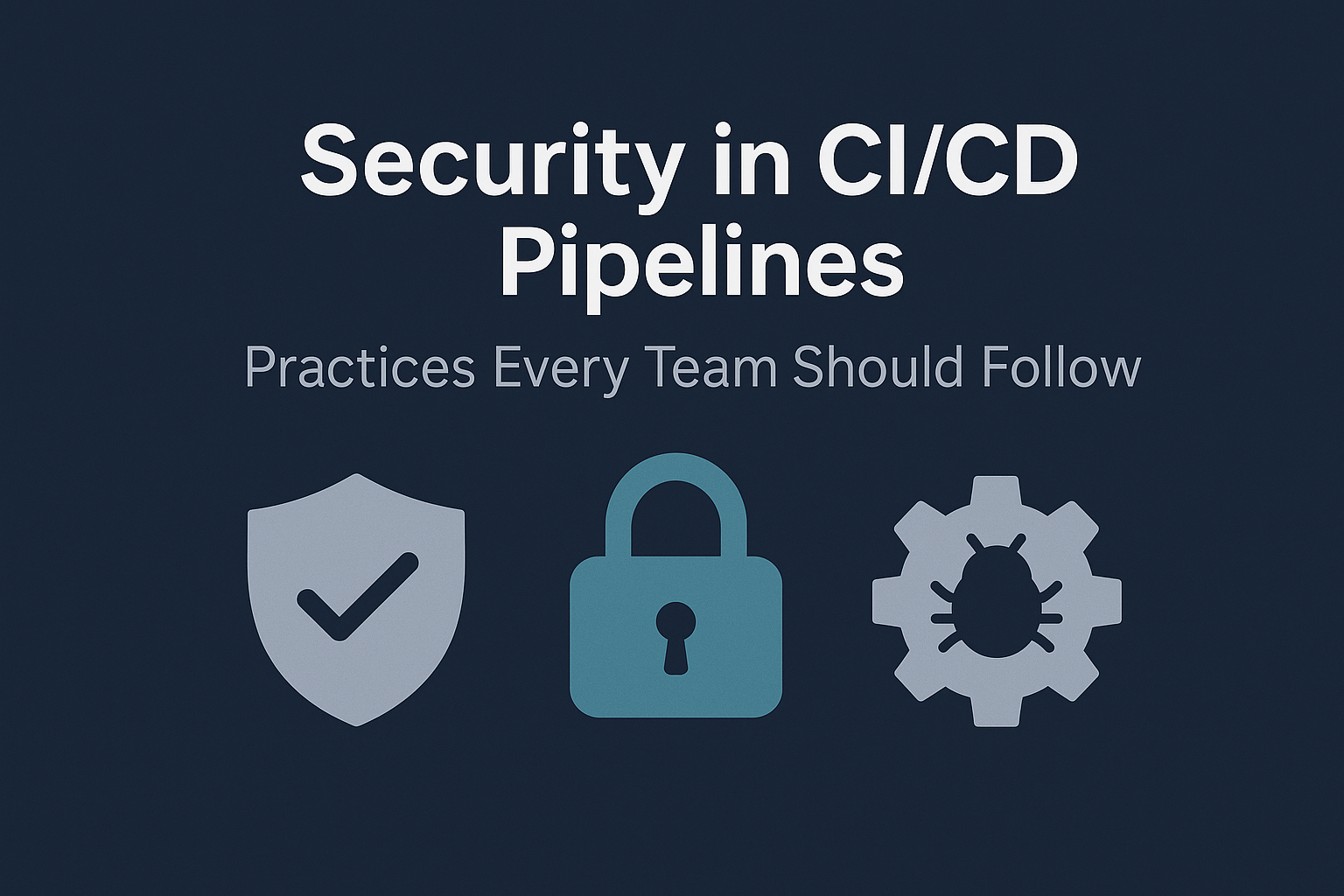Security in CI/CD Pipelines: Practices Every Team Should Follow

As organizations accelerate software delivery through CI/CD (Continuous Integration and Continuous Delivery/Deployment), the attack surface for malicious actors is also expanding. CI/CD pipelines, by their very nature, have deep access to source code, secrets, infrastructure, and production environments. A single misconfigured step or leaked credential can lead to devastating breaches.
Security can no longer be an afterthought in CI/CD. It must be baked into every stage of the pipeline—from code commit to production deployment.
In this post, we’ll explore:
Why CI/CD pipelines are a prime target
Common vulnerabilities and real-world incidents
Best practices every team should follow for secure CI/CD
Why Are CI/CD Pipelines Attractive Targets?
CI/CD pipelines often:
Have privileged access to infrastructure and production environments
Execute third-party code or scripts
Store secrets, tokens, or credentials
Integrate with external services (e.g., container registries, cloud APIs)
If compromised, attackers can:
Inject malicious code into artifacts
Access sensitive secrets or config files
Lateral move to production systems
Leak source code or IP
⚠️ Notable Incidents
Codecov breach (2021): Attackers modified a CI script to export environment variables, including secrets, from thousands of customers.
SolarWinds attack (2020): Malicious code was injected during the build process, affecting customers worldwide.
CI/CD Security Best Practices
1. Use Principle of Least Privilege
Minimize permissions for:
CI/CD service accounts
Build runners
Secrets and credentials
Never grant full admin access to your CI/CD tools or agents unless absolutely necessary. Use granular IAM roles or service accounts tied to specific pipelines or environments.
2. Secure Secrets Management
Avoid hardcoding secrets in:
Environment variables
CI/CD configuration files
Code repositories
Instead:
Use a secrets manager (e.g., HashiCorp Vault, AWS Secrets Manager, Doppler)
Encrypt secrets at rest and in transit
Inject secrets dynamically during pipeline execution
✅ Tip: Rotate credentials and API tokens regularly.
3. Isolate Build Environments
Avoid running builds on shared infrastructure across different projects or teams. Instead:
Use ephemeral build runners (e.g., GitHub Actions' hosted runners, GitLab’s autoscaling runners)
Containerize builds to reduce dependency pollution
Scan and validate containers before deployment
Isolation reduces the risk of cross-contamination between builds.
4. Scan Early, Scan Often
Integrate security scanning at multiple stages:
Static Application Security Testing (SAST): Analyze code for vulnerabilities (e.g., SonarQube, Semgrep)
Dependency Scanning (SCA): Detect known vulnerabilities in open-source libraries (e.g., Snyk, Dependabot)
Container Image Scanning: Check for CVEs in Docker images (e.g., Trivy, Clair)
Infrastructure as Code (IaC) Scanning: Detect misconfigurations in Terraform, CloudFormation, Kubernetes YAMLs (e.g., Checkov, tfsec)
✅ Tip: Fail builds if critical vulnerabilities are found.
5. Enforce Code Signing and Artifact Integrity
Protect the software supply chain by:
Signing build artifacts and container images
Verifying signatures during deployment (e.g., using Cosign or Sigstore)
Enforcing checksums and integrity verification in downstream pipelines
This ensures the artifact deployed is authentic and untampered.
6. Implement Approval Workflows
Use manual or automated gates to review:
Code changes (via pull requests and code reviews)
Deployment steps to production
Access control changes in the pipeline
Integrate policy-as-code tools (e.g., Open Policy Agent, Conftest) to enforce security and compliance rules automatically.
7. Restrict and Monitor Third-Party Integrations
Third-party plugins or actions (e.g., from GitHub Marketplace or Jenkins plugins) can be risky.
Best practices:
Vet and approve third-party tools before use
Use only pinned versions to avoid supply chain attacks
Monitor activity logs for suspicious behavior
8. Audit Logs and Monitoring
Enable detailed audit logging across:
Git repositories
CI/CD platforms
Cloud environments
Feed logs into a SIEM (e.g., Splunk, ELK, Datadog) to monitor for:
Unauthorized changes
Secret access
Unusual deployment patterns
Proactive monitoring helps detect issues early.
9. Regularly Test Your Pipeline Security
Conduct:
Pipeline penetration testing
Red teaming exercises
Misconfiguration reviews
Simulate attacks like:
Privilege escalation via CI scripts
Injecting malicious PRs
Exploiting open runners or misconfigured permissions
✅ Tip: Automate periodic reviews as part of your SDLC.
10. Educate and Train Your Teams
Security is everyone’s responsibility. Ensure developers and DevOps engineers are trained in:
Secure coding practices
Proper secrets handling
Least privilege access
Threat modeling for CI/CD systems
A well-informed team is your first line of defense.
Conclusion
Your CI/CD pipeline is the central nervous system of software delivery—and it must be protected like any other critical asset. By following the practices outlined above, you can significantly reduce the risk of breaches, maintain compliance, and foster a culture of security-first DevOps.
Security in CI/CD is not a one-time checklist. It’s a continuous process of assessment, hardening, and vigilance.
TL;DR: CI/CD Security Checklist ✅
Use least privilege for all users and runners
Store secrets in a secure vault
Isolate builds with containers or ephemeral runners
Run SAST, SCA, IaC, and image scans
Sign artifacts and verify them
Implement gated deployments and approvals
Audit third-party tools and integrations
Enable and monitor audit logs
Perform regular security reviews and testing
Train teams on secure CI/CD practices